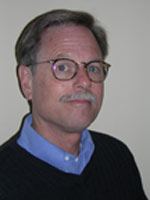|
UCSD Political Science Professors Study Partisan Division
To merely say that the U.S. is politically polarized is to state the obvious -- and to repeat the pronouncements of media pundits brandishing oversimplified red-state/blue-state charts. But understanding this important subject takes more in-depth study and two UCSD Political Science professors are doing just that. Gary Jacobson and Keith T. Poole go behind the headlines and, in two new books, take a close look at the details of partisan division and its causes.
 Gary Jacobson analyzes the reasons why the public is so divided along party lines about the George W. Bush presidency in the recently published A Divider, Not a Uniter: George W. Bush and the American People (Pearson Longman, March 2006). Gary Jacobson analyzes the reasons why the public is so divided along party lines about the George W. Bush presidency in the recently published A Divider, Not a Uniter: George W. Bush and the American People (Pearson Longman, March 2006).
According to more than 50 years of public opinion polls that have regularly measured citizens' assessments of their commanders-in-chief, George W. Bush is the nation's most divisive and polarizing president in contemporary history. Jacobson's book -- part of the publisher's "Great Questions in Politics" series -- places the current Bush presidency in context with its predecessors, examining the three decades of increased polarization between the parties, culminating with the often rancorous Bush/Gore contest and the 2000 election. Grappling with numerous issues, Jacobson finds there is no one answer for the stark divisions in the popular evaluations of this president. The book, writes Washington Post political reporter Thomas B. Edsall, is "head and shoulders above other books on the presidency of George W. Bush. Jacobson's carefully documented analysis, backed up by extensive reporting and data, demonstrates the purposefulness of the polarizing strategies of the Bush administration, and the reality behind the rhetoric of 'I'm a uniter not a divider.' Unlike most books about Bush, Jacobson's is neither ideological nor polemical."

Keith T. Poole , meanwhile, examines partisan division in Polarized America : The Dance of Ideology and Unequal Riches (MIT Press, forthcoming), with coauthors Nolan McCarty of Princeton University and Howard Rosenthal of New York University.
Increasing polarization in recent decades, the authors observe, has been closely accompanied by fundamental social and economic changes -- most notably, a parallel rise in income inequality. In Polarized America, they examine the relationships of polarization, wealth disparity, immigration and other forces, characterizing the political process as a dance of give-and-take and back-and-forth causality.
Using NOMINATE -- a quantitative procedure that scores politicians on the basis of their roll call voting records -- to measure polarization in Congress and using public opinion, census data and Federal Election Commission finance records to measure polarization among the public, the authors find that polarization and income inequality fell in tandem from 1913 to 1957 and rose together dramatically from 1977 on. They also trace a parallel rise in immigration beginning in the 1970s. In "the choreography of American politics," the authors argue, inequality feeds directly into political polarization, and polarization in turn creates policies that further increase inequality. |